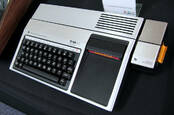This article is more than 1 year old
RetroPie 4.6 brings forth an answer to 'What do I do with this Pi 4 I bought last year?'
Fans of creaky old hardware can relive their misspent IT youth
Bought a Raspberry Pi 4 and left the poor thing mouldering in your gadget drawer? We have news – RetroPie has unleashed version 4.6 of its popular emulator suite.
For those of a certain age, the Raspberry Pi has become an essential part in recreating that whole retro-arcade feel. Rather than a full-on PC, the diminutive computer has just enough power to transport a user back to the blocky sprites and joystick-benders of yesteryear, courtesy of Linux and the multitude of emulators that run on it.
RetroPie itself is, at its core, a collection of emulators wrapped up in a vaguely user-friendly interface, navigable by joystick. In the interests of full disclosure, this hack has two ongoing projects: one to fit a Pi into a catastrophically damaged TI99 console (but requires an Arduino to deal with turning the Texas Instruments keyboard into something the Pi's USB ports will understand) and a long-planned arcade cabinet build.
With the arrival of the beefier Raspberry Pi 4 Model B, emulation fans have been anxiously waiting for the RetroPie project to move on from the venerable Pi 3 builds in the hope of taking advantage of the additional power and toys afforded by the Raspberry Pi Foundation's latest and greatest.
Development images of varying degrees of stability have existed for a while, but this week marked the release of official beta support for the Raspberry Pi 4. Naturally, we checked it out.
Firstly, we'd strongly recommend starting with the pre-built Raspberry Pi image (which is now based on Raspbian Buster) rather than trying to manually install the thing (unless you fancy some extended command line tinkering.) The nature of the Pi is such that we simply sacrificed an SD card and dumped the image on it.
The downside of that approach is that any configurations and ROMs will need to be copied across. Not the end of the world, but might be a pain for some.
The RetroPie gang reckons that "most packages run well" and we'd have to agree. Equally, stuff that was borked on previous versions remained borked here: we still stalled at the Sinclair Research text when trying out the prototype ZX Spectrum ROM available from the Centre for Computing History. The version of Fuse in the distribution seemed to be not impressed by it.
It is also a reminder that RetroPie is dependent on its collection of emulators - if something doesn't work, then tinkering with its internals is always there for the brave.
Other favourites behaved as well as they had always done, and we're looking forward to seeing what the community does with the extra resources on offer from the Raspberry Pi 4.
The RetroPie team told The Register that it hoped the project might exit beta in a couple of months, adding that "The new Raspberry Pi 4 required us switching to different GPU drivers/software stack. There was a lot of additional logic needed and fixes/changes to various components including core libraries like sdl2."
The team added that the lengthy wait was because "We include a lot of software, so it took time to test and fix up everything."
"The Emulation Station front-end has had a lot of improvements made," the team told us. The project also contributes back to software included and expects more additions and improvements over the coming months.
So, if you've got some time on your hands and a Pi 4 you bought because it seemed a good idea at the time, we'd suggest a virtual trip to the a dingy arcades of decades past or a Pi-based resurrection of the long dead home computer in the attic. Alternatively, you could try to build a Kubernetes cluster.
But that Spectrum ROM is calling. ®

